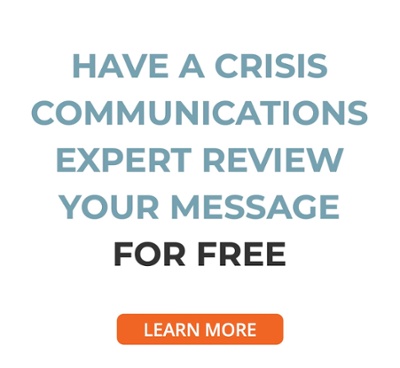Regardless of the method of delivery, there are a few major considerations to make when communicating through these anxiety-ridden times.
This list of curated articles is intended to help you cut through the noise and quickly find the information that will help you build a messaging strategy. Crisis communications Cliffs Notes, if you will…
Communicating Through the Coronavirus Crisis (Harvard Business Review)
Building a COVID-19 messaging strategy may seem daunting, especially since the situation seems to change every day. It’s important to have a plan in place to ensure seamless creation, review and deployment of communications that are relevant and directed toward the correct audiences.
This article by the Harvard Business Review is a crash course in crisis communications strategy best practices, detailing out a five-step process:
- Create a team for centralized communication
- Communicate with employees
- Communicate regularly with customers
- Reassure shareholders
- Be proactive with communities
Along with the helpful tips, we appreciated the reminder from the author to be transparent with your audience and to put yourself in their shoes. You may not know everything, but you should communicate as much and as often as you can.
Using Collaborative Language is Essential in Times of Crisis (Fast Company)
With employees being furloughed or being asked to work from home, isolation is impacting many people in a negative way. It is always important to communicate collaboratively, but even more so in these trying times as a means of reminding employees that we are one group, working together.
This article by Fast Company stands out to us because it acknowledges the need for this kind of communication as a response to the physical distance many of us are experiencing, and it provides four actionable steps that will improve your crisis communications and make your audience feel connected.
Tips for Communicating Layoffs During the Pandemic (PR News)
Layoffs are likely one of the most difficult topics to communicate about, and with the unemployment rate in the United States expected to rise while we globally attempt to stop the spread of COVID-19, it’s a topic that will unfortunately impact many people and businesses.
This article by PR News details out best practices when communicating job loss as well as how to move forward after reducing a workforce. It reminds employers to be wise with the timing and tone of communications, ensuring that those whose employment is impacted are notified privately, sensitively and before any larger announcements are made.
With additional tips such as providing definitions of what specific language means and how to move forward to focus on the employees who remain, this article can be helpful to refer to if necessary.
I Feel Ya: How to Connect With Your Audience Using Empathy (Craft Impact)
It’s often assumed that speaking is the most important aspect of communication, but the reality is that listening and being empathetic is a crucial part of the communication process. With heightened anxiety that many are experiencing, empathizing with and understanding the people who you are speaking to will change the way your message is received.
While not directly related to coronavirus, this article provides helpful advice on listening to your audience, giving emotional validation and using the appropriate timing and tone. In this period of unknowns, we find these tips and action steps to be very relevant and helpful.
5 Ways to Do Smart & Responsible Marketing During COVID-19 (Business 2 Community)
Continuing business while comforting and protecting employees and customers is a difficult balancing act. While business should continue, it cannot continue as usual and will require some added awareness and sensitivity. Unfortunately, that may mean you have to delay certain initiatives and hit snooze on some of the plans you had for your business in the coming quarter.
This article provides actionable insights for adjusting marketing and communication strategies during this global crisis and encourages helpfulness as opposed to profiting off the situation or contributing to the panic. As the title suggests, they expound five ways to do this:
- Adjust marketing campaigns and scheduled content timelines
- Evaluate your imagery and language
- Don’t capitalize on the crisis
- Be positive, but not ignorant
- Highlight how your brand can help
The author ends the article on a positive note with the reminder that we all need: “The quarantine won’t last forever.”
Leading Through COVID-19: Communicating With Your Employees (BDO Canada)
Internal communication has always been a normal part of leading a team, and it is now more necessary than ever before so that your employees trust you to guide them through the current era. Creating a plan to communicate with your employees during the pandemic should be a top priority.
This article lists three components that must be in your COVID-19 communication strategy: informing, reassuring, and directing. In addition to giving practical advice for how to meet those criteria, the author specifies what effective communication entails and points out that navigating the current situation well will improve trust in your organization in the future.
‘Everything Will Be OK’ (Korn Ferry)
Continuing the discussion of the arduous role of leaders during this time, we can’t forget the responsibility that leaders have to maintain and communicate hope within their businesses. It may feel like a burden for leaders who are experiencing the same anxiety and fear as their employees are, but an “everything will be ok” mindset is a tool that can help us come out of this even stronger.
In this article, Gary Burnison, CEO of Korn Ferry, reminds us that “hope camouflages fear,” and shares his thoughts on how leaders can serve as conductors of hope. He gives in depth explanations of the following ideas:
- Listen to educate your intuition
- Have the end in mind
- Don’t mentally shelter in place
- Connect the dots in between
- Hope is resilience
- “The courageous have no fear”
Are there any topics you’re struggling to communicate about during these uncertain times? We’re happy to help. Send us a message and let us know.
If you’d like a free , confidential video consultation of an upcoming crisis communication, feel free to reach out. Or, for more helpful resources in crisis, subscribe to our newsletter using the form below.


